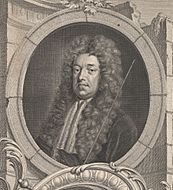Godolphin–Marlborough ministry facts for kids
Quick facts for kids Godolphin–Marlborough ministry |
|
|---|---|
| 1702-1710 | |
|
Engravings of Lord Godolphin (left) and the Duke of Marlborough (right)
|
|
| Date formed | May 1702 |
| Date dissolved | 8 August 1710 |
| People and organisations | |
| Monarch | Anne |
| Lord High Treasurer | Lord Godolphin |
| Master-General of the Ordnance | The Duke of Marlborough |
| Member party | Tory Whigs |
| Status in legislature | Majority coalition (England, and GB after 1707) Outside of Parliament (Scotland) 482 / 513
(1702-1705)493 / 513
(1705-1708)513 / 558
(1708-1710) |
| Opposition cabinet | None |
| History | |
| Election(s) | England:
1702 Great Britain: 1708 |
| Legislature term(s) | 1st Parliament of Queen Anne (England) 1702-1707 Scottish Parliament (Scotland) 1st British Parliament (after 1707) |
| Successor | Harley ministry |
This article is about the main government leaders, known as "ministers," who served Queen Anne when she became queen in 1702. This group was led by two important figures: Lord Godolphin and the Duke of Marlborough. They worked together to run the government of England, and later, Great Britain. Their time in power ended on August 8, 1710, when Lord Godolphin was removed from his position. After that, a new government, called the Harley ministry, took over.
Contents
Queen Anne's First Government
When Queen Anne became queen of England in 1702, she chose her key advisors. She appointed Lord Godolphin as her chief financial officer, known as the Lord High Treasurer. She also made the Duke of Marlborough the head of the army's weapons and supplies, called the Master-General of the Ordnance. These two men became the main leaders of her government.
Working Together: Tories and Whigs
The government they led was a mix of two main political groups: the Tories and the Whigs. Think of them like different teams with slightly different ideas about how the country should be run. This partnership lasted until 1708. By then, a major change had happened: the Act of Union in 1707 joined England and Scotland to form the new Kingdom of Great Britain.
Changes in Power: From Tories to Whigs
The government went through a few phases. At first, from 1702 to 1704, it was mostly made up of Tories. Both Lord Godolphin and the Duke of Marlborough were Tories themselves. However, things started to shift. After 1704, Godolphin and Marlborough began to seek support from a different group of Whigs.
Over time, more Whigs joined the government. This happened because the main ministers liked that the Whigs strongly supported a big war happening at the time, called the War of the Spanish Succession. As more Whigs gained important roles, one of the earlier Whig leaders, Robert Harley, started to disagree with the government's direction.
The Final Years and Collapse
When Robert Harley left the government in 1708, the Whigs had even more control. Important Whig leaders took over key positions. However, this didn't last forever. In 1710, Queen Anne decided to make a big change. She turned to Robert Harley and the Tories for support. She dismissed Lord Godolphin and the Whig leaders from their jobs. Soon after, the Duke of Marlborough also lost his position. This marked the end of their government.
See also
- 1st Parliament of Great Britain 1705–1708
- 2nd Parliament of Great Britain 1708–1710



